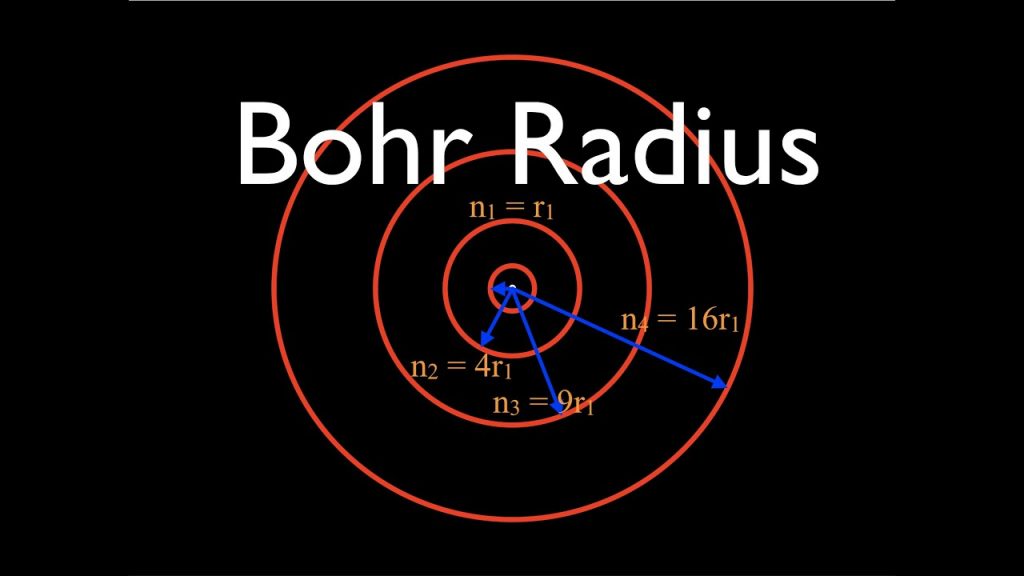The Bohr Radius is a physical constant, that was formulated by Neils Bohr during the Bohr model, thus named after him. It is denoted by \(a_0\).
It is approximately equal to the most probable distance from the nucleus and the electron in a hydrogen atom in its ground state.

Index
Bohr Radius Definition
The physical constant \(a_0\) is given as,
\(\large{a_0 = \frac{4 \pi \epsilon_0 \hbar^2}{m_e e^2} = \frac{\epsilon_0 h^2}{\pi m_e e^2} = \frac{\hbar}{m_e c \alpha}}\)
Where,
\(\epsilon_0\) – Permittivity of Free Space
\(\hbar\) – Reduced Planck Constant
\(e\) – Elementary Charge
\(m_e\) – Mass of an Electron
\(c\) – Speed of Light in Vacuum
\(\alpha\) – Fine-structure Constant
Bohr Radius Value
Bohr radius value is 5.29177210903(80) ✕ 10-11 m.
The table below presents the Bohr model radius for a hydrogen atom in different units.
| Units | Bohr Radii |
| SI Units | 5.29 ✕ 10-11 m |
| Imperial Units | 2.08 ✕ 10-9 in |
| Natural Units | 2.68 ✕ 10-4 /eV 3.27 ✕ 1024 lp |
Derivation of Bohr Radius
As we know,
Centripetal Force = \(\frac{mv^2}{r}\)
Electrostatic Force = \(\frac{1}{4 \pi \epsilon_0} . \frac{ze^2}{r^2}\)
In a hydrogen atom, Electrostatic force = Centrifugal force
\(\Rightarrow \frac{1}{4 \pi \epsilon_0} . \frac{ze^2}{r^2} = \frac{mv^2}{r}\)
\(\Rightarrow v^2 = \frac{1}{4 \pi \epsilon_0} . \frac{ze^2}{mr} … (1)\)
From Bohr’s quantum equation,
\(L = mvr = n \hbar … (2)\)
Where, \(\hbar = \frac{h}{2 \pi}\)
By solving \((2)\),
\(v = \frac{n \hbar}{mr}\)
Substituting \(v\) in \((1)\),
\((\frac{n \hbar}{mr})^2 = \frac{1}{4 \pi \epsilon_0} . \frac{ze^2}{mr}\)
\(\Rightarrow r = \frac{4 \pi \epsilon_0 (n \hbar)^2}{mze^2} … (3)\)
As we know, \(4 \pi \epsilon_0 = 1/9 ✕ 10^9\)
And, \(\hbar = \frac{h}{2 \pi} = \frac{6.625 ✕ 10^{-34}}{2 \pi}\)
Radius of a hydrogen atom with n = 1, m = 9.11 ✕ 10-31 kg, z = 1 and e = 1.6 ✕ 10-19 C can be calculated by substituting these values in \((3)\).
\(\Rightarrow r = \frac{(\frac{1}{9} \times 10^9)(1)^2(\frac{6.625 \times 10^{-34}}{2 \pi})^2}{(9.11 \times 10^{-31})(1)(1.6 \times 10^{-19})^2}\)
Simplifying this we get,
\(r = 5.2917721067 \times 10^{-11} m\).
Applications
As Bohrs radius is applicable only to Hydrogen and Hydrogen like atoms, it is not much used in modern physics. But it is still used for the following applications:
- Atomic unit
- Fine structure constant
FAQs
It is a physical constant, approximately equal to the most probable distance from the nucleus and the electron in a hydrogen atom in its ground state.
The value of the physical constant is 5.29177210903(80)✕10-11m.
Related Topics:
